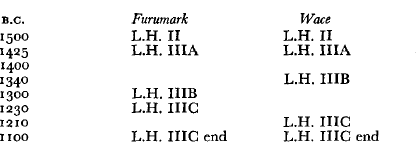Article contents
Part I. Preliminary Report on the Excavations of 1952
Published online by Cambridge University Press: 11 October 2013
Extract
The British excavations at Mycenae in 1952 were conducted with a research grant from the American Philosophical Society assisted by contributions from the Universities of Cambridge and Oxford, the British Academy, the Leverhulme Trustees, and the British School at Athens under whose aegis the work was carried out.
The excavations began on June 30th, and all active digging ceased on August 18th, though several days were needed to clear up everything and transport the finds to the National Museum in Athens and the Nauplia Museum. Of the finds the bronzes, the ivories, the inscribed tablets, and some pottery wanted for special study were taken to Athens and everything else taken to Nauplia and placed in a separate room. Of the pottery the archaic and classical pottery and the terracotta figurines from the sanctuary by the Causeway, from the excavations of 1950 and 1952, and most of the classical and Hellenistic fragments from the Perseia Fountain House are now in Athens. All the prehistoric pottery except for a few select pieces is in the Nauplia Museum.
- Type
- Mycenae
- Information
- Copyright
- Copyright © The Council, British School at Athens 1953
References
1 The manuscript of this report has been read by Dr. Stubbings, by Miss Dow, and by my wife and daughter, and has been much improved by their criticisms. The responsibility for it, however, remains mine. It was prepared in the autumn of 1952 while I was a member of the Institute for Advanced Study at Princeton. My best thanks are due to Mr. John Travlos, Professor R. Stillwell, and Mrs. Evelyn Smithson for kind help with the plans.
2 PAE 1950, 215, fig. 18.
3 PAE 1950, 203–33.
4 BSA XXV 403 ff.
5 Stevens, , Hesperia XV (1946), 73 ff.CrossRefGoogle Scholar
6 Seltman, , Athens, its History and Coinage 4 f.Google Scholar, figs. 3, 4. Compare Svoronos, JIAN IX (1906), 153 ff., pls. II–V.Google Scholar See also Schaeffer, , Enkomi-Alasia 27 ff.Google Scholar
7 BSA XLV 204 ff.
8 Wace, , Mycenae, pl. 80r.Google Scholar
9 BSA XLV 209, fig. 2.
10 Compare Homer, , Odyssey XIX 56.Google Scholar
11 Shear, , Hesperia IX (1940), 283 ff., figs. 27–29.Google Scholar
12 Illustrated London News, Oct. 25, 1952, 683, figs, 11, 13.
13 BSA XLV 209, fig. 2.
14 Schaeffer, , Enkomi-Alasia, 379 ff.Google Scholar, fig. 116 ff., pls. C, D, CXVI.
15 JHS 1951, 255 ff., figs. 1, 2.
16 Compare Evans, , Prehistoric Tombs of Knossos (Archaeologia LIX), 44, fig. 41.Google Scholar The handles on the steatite pithoi from the Tomb of Clytemnestra may have been in the form of figure-of-eight shields, BSA XXV 367 f., fig. 80; Wace, , Mycenae 38Google Scholar, n. 3.
17 This is what Homer apparently called κρήδεμνον, Odyssey III 392.
18 At the Menelaion the sealed spout of a large stirrup jar was found, Dawkins, , BSA XVI 9.Google Scholar The Nauplia Museum example may be from Tiryns, see AA 1935, 75, 82, fig. 8. Other instances of stoppers are given by von Mercklin in the same article, ibid. 74 ff.
19 The tablets are edited by DrBennett, Emmett in the Proceedings of the American Philosophical Society, vol. 97 (1953), 422 ff.Google Scholar
20 Compare the sphinxes on a comb from Spata, Perrot-Chipiez, , Hist. de l'Art 637Google Scholar, fig. 284.
21 Several fragments of fresco of the same style were found under the floor of Room 5 with L.H. IIIA vase fragments.
22 The dating (1300–1230 B.C.) suggested by Furumark, (Chronology of Mycenaean Pottery 115)Google Scholar for this stage is not acceptable, for he gives one hundred and twenty-five years to the L.H. IIIA stage (which to judge by the amount of pottery so far known cannot have been so long) and only seventy years to the L.H. IIIB stage (to which belongs an enormous amount of pottery). It is better thus to shorten Furumark's L.H. IIIA stage and place its end not long after the close of the Amarna epoch and to expand the L.H. IIIB stage accordingly by the same amount at its beginning. I would put the transition from the B to the C stage in the last quarter of the thirteenth century B.C. Furumark actually dates the end of his B stage and the opening of his C stage to 1230 B.C. I would prefer to regard the last quarter of the thirteenth century as a transitional phase between the B and C stages. Thus I suggest the date 1210 B.C. as an approximate date for the division between B and C. We can tabulate my suggestions with Furumark's thus:

The years just after 1425 B.C. and on either side of 1210 B.C. I would regard as transitional periods between L.H. II and L.H. IIIA and between L.H. IIIB and L.H. IIIC. I would prefer not to try to define at present Furumark's subdivisions of L.H. II, L.H. IIIA, and L.H. IIIC pending the accumulation of further evidence. Precise dating of any phase of Mycenaean pottery is a refinement which our present knowledge does not justify.
23 Säflund, , Le Terremare 167 f.Google Scholar; pls. 53, 54. His pl. 53, 3 seems to be the nearest parallel for this mould. Compare Montelius, , Vorklassische Chronologie Italiens, pl. IX 14Google Scholar, pl. XIV 7a. I owe these references to Professor Gordon Childe.
24 BSA XXV 403 ff.
25 PAE 1950, 203 ff.; JHS 1951, 239 f.
26 JHS 1952, 97 f.
27 BSA XVI 9 f., fig. 5, pl. III.
28 Wace, , Mycenae, 123, 135.Google Scholar
29 JHS 1951, 257.
30 Karten von Mykenai, pl. I.
31 Karo, , AJA 1934, 123 ff.CrossRefGoogle Scholar
- 2
- Cited by


